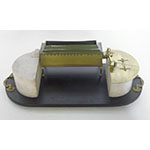The apparatus was used to measure the dilation of metal rods when heated. It rests on a slate base with white marble uprights. The test metal rod (in this case, an iron rod) is heated by immersion in a brass vessel containing hot water. When the rod expands, it pushes a brass lever that moves a pointer on a graduated scale. The pointer is connected to a helical spring, allowing it to move in either direction. The instrument was designed in 1731 by Petrus van Musschenbroek, who called it "pyrometer"; today, the term "dilatometer" is preferred. In Musschenbroek's model, the test rod was heated by a row of flames from spirit lamps. Later, baths of hot liquid were used. Provenance: Lorraine collections.
Provenance
Inventors
Context
In depth










